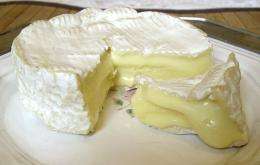January 9, 2012 report
Swiss chemists emulate cheese rind to create self-cleaning surface material

(PhysOrg.com) -- Cheese lovers know that the milky white outer coating of Camembert cheese not only serves to offer a tart offset to the pungent inner cheese, but also protects it until ready to be eaten, much like plastic wrap does for other foods. Now, a group of Swiss researchers have taken this idea heart, and have created a sort of artificial rind. As they describe in their paper published in the Proceedings of the National Academy of Sciences, they have created a bio-sandwich of sorts using a type of cheese fungus to create a material that eats organic material that comes into contact with it.
The idea was to create a material that mimics what the rind does for Camembert cheese, i.e. protect it from other microorganisms, while at the same time allowing the cheese inside to mature. To construct such a material, they started with a sheet of thin plastic which they covered with Penicillium roqueforti, a fungus mixture known more familiarly as the stuff that makes blue cheese blue. They then covered that with a type of plastic material that was just porous enough to keep the fungus in while still allowing liquids to pass through. And that was all it took. To test their new material, they dropped a little bit of a sugar solution onto the material, then sat back to watch what happened. Though it took two weeks, the sugar was completely eaten by the fungus, leaving the newly created material, sparkling clean.
Perhaps what was even more compelling was that the fungus went back to being dormant after it had eaten the sugar, meaning it could conceivably sit there indefinitely, only coming alive, so to speak, when once again food is dropped onto it. All that is necessary to keep it from dying, is to ensure that it doesn’t ever dry out completely. Thus, all that’s needed is a small amount of moisture in the air around it.
The whole concept seems so basic, it’s hard to understand why no one has thought of creating such materials before. What if self-cleaning countertops were made of such material for example, keeping them forever free of dangerous bacteria, or thinking bigger, as the team suggests, what if the surface of skyscrapers were covered in such a sandwich but instead of blue cheese fungus, algae could be used to convert carbon dioxide to oxygen. Clearly, this simple idea could lead to truly revolutionary new types of material coverings.
More information: Incorporating microorganisms into polymer layers provides bioinspired functional living materials, PNAS January 3, 2012 vol. 109 no. 1 90-94. doi: 10.1073/pnas.1115381109
Abstract
Artificial two-dimensional biological habitats were prepared from porous polymer layers and inoculated with the fungus Penicillium roqueforti to provide a living material. Such composites of classical industrial ingredients and living microorganisms can provide a novel form of functional or smart materials with capability for evolutionary adaptation. This allows realization of most complex responses to environmental stimuli. As a conceptual design, we prepared a material surface with self-cleaning capability when subjected to standardized food spill. Fungal growth and reproduction were observed in between two specifically adapted polymer layers. Gas exchange for breathing and transport of nutrient through a nano-porous top layer allowed selective intake of food whilst limiting the microorganism to dwell exclusively in between a confined, well-enclosed area of the material. We demonstrated a design of such living materials and showed both active (eating) and waiting (dormant, hibernation) states with additional recovery for reinitiation of a new active state by observing the metabolic activity over two full nutrition cycles of the living material (active, hibernation, reactivation). This novel class of living materials can be expected to provide nonclassical solutions in consumer goods such as packaging, indoor surfaces, and in biotechnology.
Journal information: Proceedings of the National Academy of Sciences
© 2011 PhysOrg.com
















